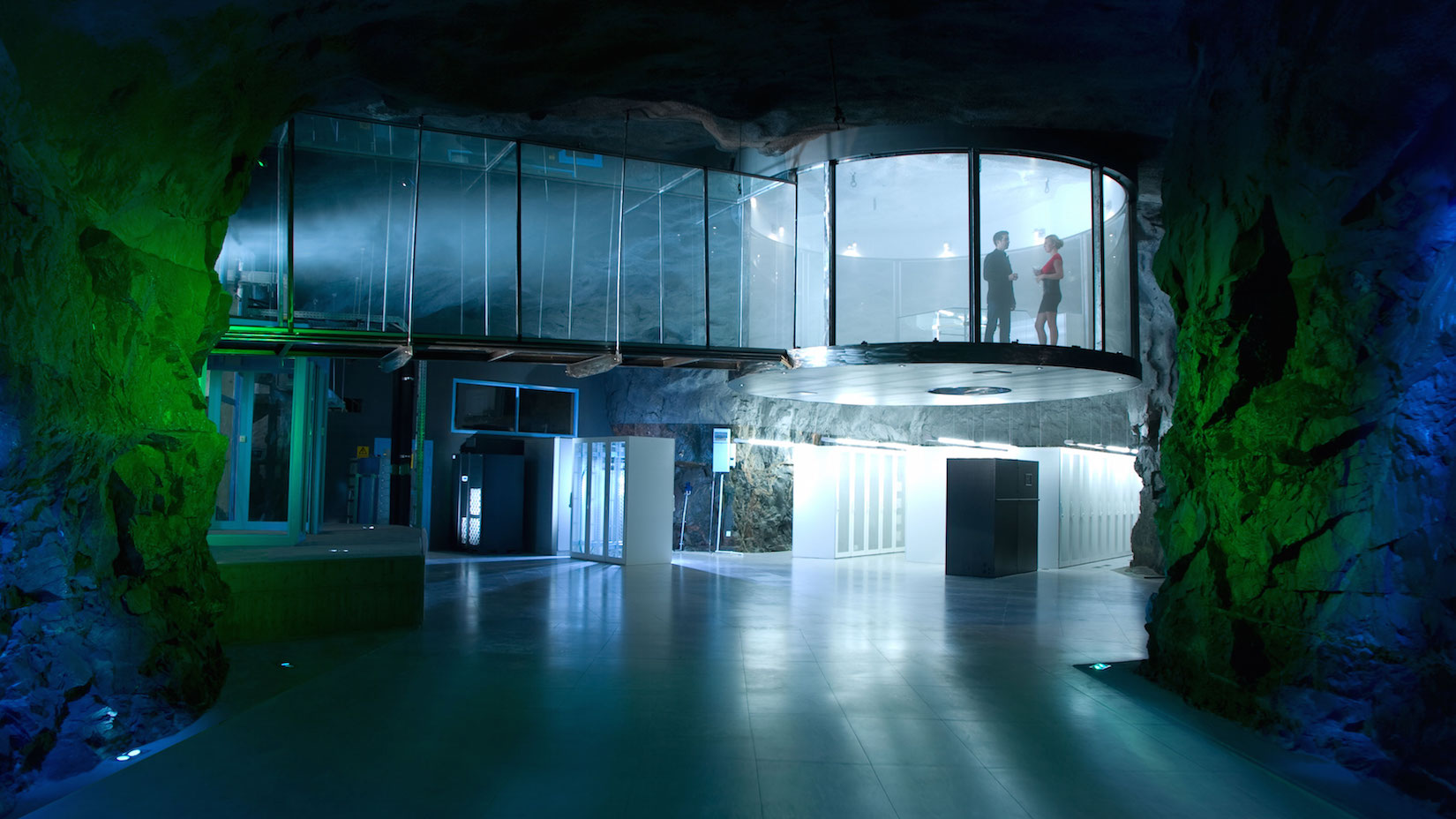This underground data center has greenhouses, waterfalls, German submarine engines, simulated daylight and can withstand a hit from a hydrogen bomb. It looks like the secret HQ of a James Bond villain.
And it is real. It is a newly opened high-security data center run by one of Sweden’s largest ISPs, located in an old nuclear bunker deep below the bedrock of Stockholm city, sealed off from the world by entrance doors 40 cm thick (almost 16 inches).
(For the curious there is plenty of more information further down.)
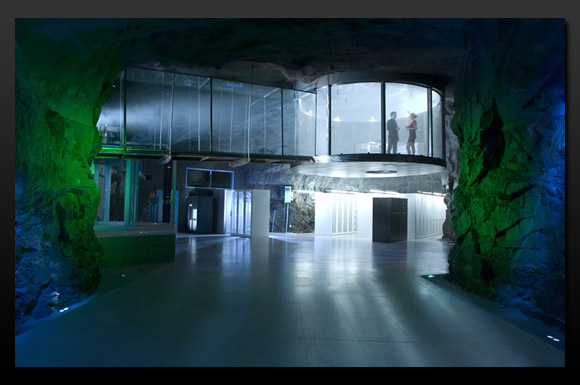
Above: The space-themed conference room is suspended about the server hall.
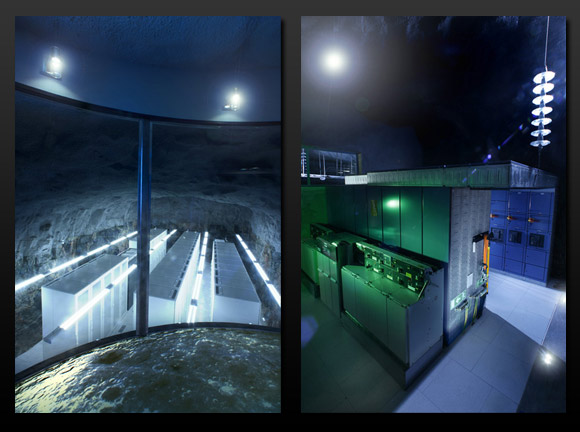
Above left: View from the conference room (its floor is the surface of the Moon). Above right: Power equipment.
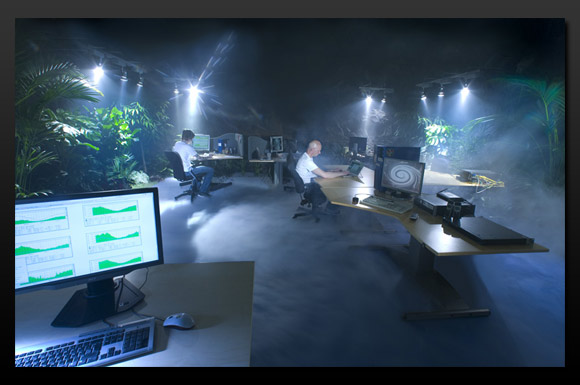
Above: The NOC is set in a cozy jungle setting. That light fog almost makes us think of cloud computing. Fog computing? 🙂
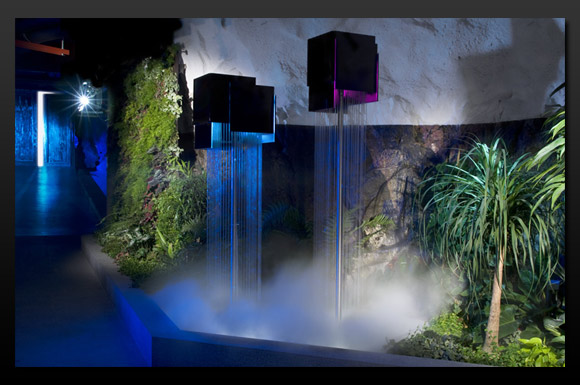
Above: Artificial waterfalls and plenty of green plants adorn the halls.
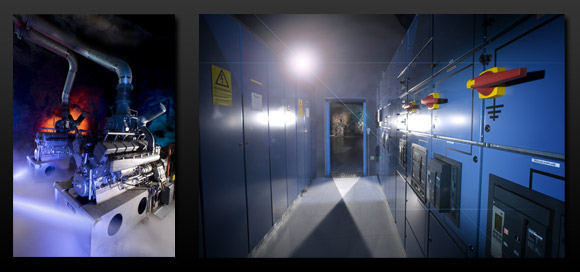
Above left: The submarine engines used for backup power. Above right: Another view of the power equipment.
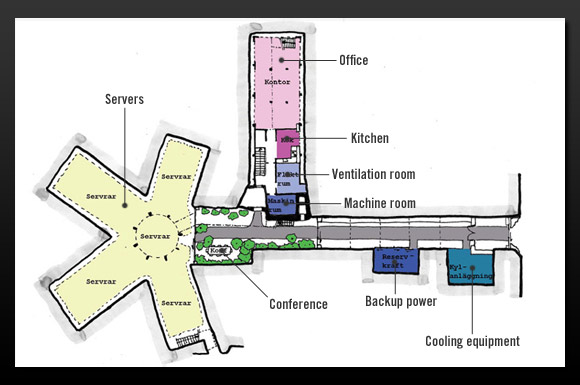
Above: This map shows the layout of the data center. Original image courtesy of Albert France-Lanord Architects (Pingdom added the English translation).
And here is what it used to look like

Quite a difference, isn’t it? 🙂
Facts about the data center
- Originally a nuclear bunker: The data center is housed in what was originally a military bunker and nuclear shelter during the Cold War era. The facility still has the code name from its military days: Pionen White Mountains.
- Located in central Stockholm below 30 meters (almost 100 ft) of bedrock: The facility has 1110 sqm (11950 sq ft) of space and is located below 30 meters of solid bedrock (granite) right inside the city.
- Fully redesigned in 2007-2008: Pionen was completely redesigned in 2007-2008 to become the data center that it is today. More than 4,000 cubic meters (141,300 cubic ft) of solid rock was blasted away to make more room.
- Can withstand a hydrogen bomb: The bunker was designed to be able to withstand a near hit by a hydrogen bomb.
- Houses the Network Operations Center for one of Sweden’s largest ISPs: The bunker houses the NOC for all of Bahnhof’s operations. They have five data centers in Sweden, Pionen being the largest. The facility also acts as a co-location hosting center, so you can actually put your own servers here.
- German submarine engines for backup power: Backup power is handled by two Maybach MTU diesel engines producing 1.5 Megawatt of power. The engines were originally designed for submarines, and just for fun the people at Pionen have also installed the warning system (sound horns) from the original German submarine.
- 1.5 megawatt of cooling for the servers: Cooling is handled by Baltimore Aircoil fans producing a cooling effect of 1.5 megawatt, enough for several hundred rack-mounted units.
- Triple redundancy Internet backbone access: The network has full redundancy with both fiber optics and extra copper lines with three different physical ways into the mountain. Pionen is one the best-connected places in northern Europe.
- Work environment with simulated daylight and greenhouses: For a pleasant working environment the data center has simulated daylight, greenhouses, waterfalls and a huge 2600-liter salt water fish tank.
- Staff: 15 employees, only senior technical staff, work full time in Pionen.
Breaking the mold and focusing on humans
We simply couldn’t resist the temptation to ask the people behind the Pionen data center what made them design such an insanely cool and unusual environment deep inside the bedrock of Stockholm.
Jon Karlung, CEO at Bahnhof (the ISP behind Pionen), was kind enough to take the time to speak to us here at Pingdom and explain their motivations.
“Rather than just concentrating on technical hardware we decided to put humans in focus,” he said. “Of course, the security, power, cooling, network, etc, are all top notch, but the people designing data centers often (always!) forget about the humans that are supposed to work with the stuff.”
We suspected that the unique location itself must have been a big inspiration, something which Karlung confirms.
“Since we got hold of this unique nuclear bunker in central Stockholm deep below the rock, we just couldn’t build it like a traditional – more boring – hosting center,” he said. “We wanted to make something different. The place itself needed something far out in design and science fiction was the natural source of inspiration in this case – plus of course some solid experience from having been a hosting provider for more than a decade.”
The visual inspiration
So, where to turn for visual inspiration? Apparently movies were the way to go for Pionen.
“I’m personally a big fan of old science fiction movies. Especially ones from the 70s like Logan’s Run, Silent Running, Star Wars (especially The Empire Strikes Back) so these were an influence,“ said Karlung. “James Bond movies have also had an impact on the design. I was actually looking for the same outfit as the villain ‘Blofeld’ in Bond and even considered getting a white cat, but that might have been going a bit far!”
The marketing aspect
The unique approach also helps the company to get the word out about their facility. It makes them stand out, and since the facility offers co-location hosting, they have customers who frequently visit the place and work there. These people share what they see with others.
“The unique design makes it a ‘talk about’ facility,” said Karlung.”If you have been inside Pionen you will for sure tell somebody else about it.”
Do you know of other awesome data centers?
We here at Pingdom always love it when people step up to the plate and do something different, like what Bahnhof has done with this awesome data center.
If you know of other data centers that are as super-designed and different as this one, please let us know in the comments since we would love to check them out. Links to pictures and information are always welcome!
A big thank you to Jon Karlung at Bahnhof for providing us with extra information and taking the time to answer all our questions. You can read more about the Pionen data center at the Bahnhof website (in Swedish, though).





